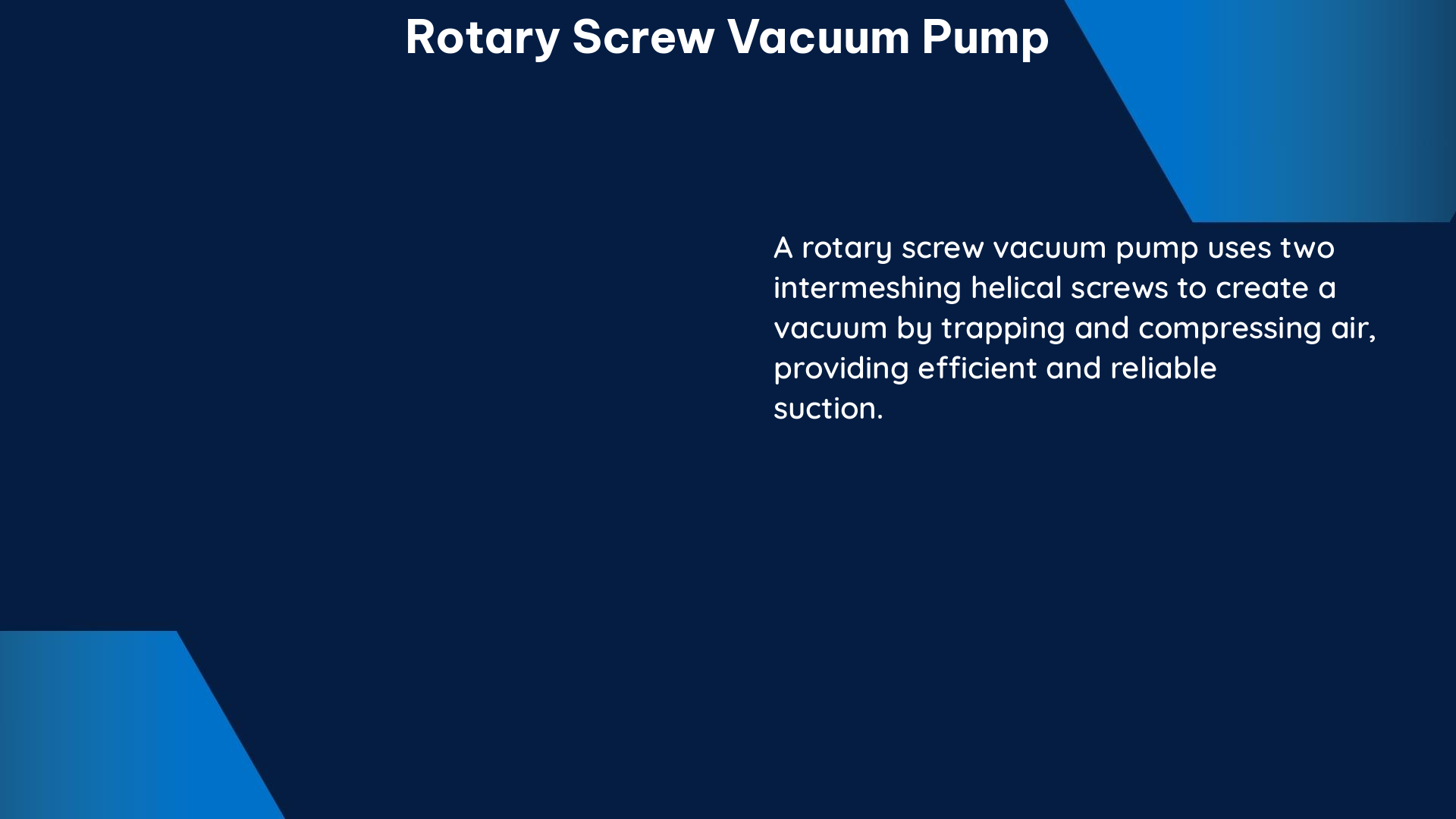The rotary screw vacuum pump is a highly advanced and critical piece of equipment that operates by continuously changing the pressure in a container. Its performance is influenced by several factors, including geometrical pumping speed, net output, and leaks. This comprehensive guide will delve into the technical specifications, performance prediction, and market analysis of the rotary screw vacuum pump.
Technical Specifications of Rotary Screw Vacuum Pump
The rotary screw vacuum pump comprises the following key components:
- Screw Rotors: The pump features a pair of screw rotors, typically made of high-quality materials such as stainless steel or aluminum alloy, that rotate in opposite directions to create the vacuum.
- Stator: The stator is the stationary component that surrounds the screw rotors, providing the necessary housing and support for the pump’s operation.
- Plate: The plate is a critical component that separates the main flow field and the clearance flow field within the pump.
- Exhaust End: The exhaust end is responsible for the discharge of the air or gas that has been evacuated from the container.
The fluid domain within the rotary screw vacuum pump is divided into two distinct regions:
- Main Flow Field: This is the primary flow path where the majority of the air or gas is evacuated.
- Clearance Flow Field: This is the region between the screw rotors and the stator, where leakage and backflow can occur.
The grid system used in the analysis of the rotary screw vacuum pump is typically an unstructured mesh, and the governing equations are based on the k-ε two-equation model. The numerical solution of the finite differential equations employs the following techniques:
- SIMPLEC Algorithm: The semi-implicit pressure linked equations-corrected (SIMPLEC) algorithm is used for the pressure-velocity coupling.
- TDMA Line-by-Line Iteration: The tri-diagonal marching algorithm (TDMA) is used for the line-by-line iteration.
- Under-Relaxation Quadratic Upstream Interpolation: The under-relaxation quadratic upstream interpolation is used for the convective terms.
- QUICK Procedure: The convective kinematics (QUICK) procedure is used for the discretization of the convective terms.
- CDS for Diffusion Terms: The central difference scheme (CDS) is used for the discretization of the diffusion terms.
The boundary conditions for the rotary screw vacuum pump include:
- Pressure Boundary Condition: The inlet pressure is set to 96 Pa, 178 Pa, 293 Pa, 508 Pa, or 861 Pa, while the exit pressure is approximately 101,325 Pa.
- Velocity Boundary Condition: The velocity boundary condition is applied to the outer surface of the screw rotors, with the female screw rotor speed at approximately 2,900 r/min and the male screw rotor speed also at 2,900 r/min.
Performance Prediction of Rotary Screw Vacuum Pump

The performance of the rotary screw vacuum pump can be predicted using a performance prediction algorithm that balances the following key factors:
- Geometrical Pumping Speed: This refers to the theoretical maximum flow rate that the pump can achieve, based on its physical dimensions and design.
- Net Output: The net output is the actual flow rate of the pump, taking into account factors such as leakage and backflow.
- Leaks: Leaks within the pump can significantly impact its overall performance, and must be accounted for in the prediction algorithm.
Researchers have also developed finite volume models to analyze the distributions of velocity, pressure, and temperature within the twin-screw pump clearances using numerical simulation methods. These models provide valuable insights into the complex fluid dynamics within the pump, enabling further optimization and performance improvements.
Market Analysis of Rotary Screw Vacuum Pump
The market for rotary screw vacuum pumps is expected to experience significant growth in the coming years. According to market research, the global rotary screw vacuum pump market is projected to reach a valuation of USD xx.x Billion by 2023, and is further expected to achieve USD xx Billion by 2031.
The market study offers an in-depth assessment of various customers’ journeys pertinent to the rotary screw vacuum pump market and its segments. This comprehensive analysis provides valuable insights into the evolving customer preferences, market trends, and potential growth opportunities.
Conclusion
The rotary screw vacuum pump is a highly advanced and critical piece of equipment that plays a crucial role in various industrial applications. This comprehensive guide has delved into the technical specifications, performance prediction, and market analysis of the rotary screw vacuum pump, providing a wealth of information for both industry professionals and DIY enthusiasts.
By understanding the intricate details of the rotary screw vacuum pump, users can make informed decisions, optimize their operations, and stay ahead of the curve in this rapidly evolving market.
References
- Effects of Stable Clearances on Backflow in the Variable-Pitch Screw Vacuum Pump
- Numerical Simulation of the Fluid Flow in a Rotary Screw Vacuum Pump
- Rotary Screw Vacuum Pump Market Research Report
- Rotary Screw Vacuum Pump Market
- Rotary Screw Vacuum Pump Market Size and Scope

The lambdageeks.com Core SME Team is a group of experienced subject matter experts from diverse scientific and technical fields including Physics, Chemistry, Technology,Electronics & Electrical Engineering, Automotive, Mechanical Engineering. Our team collaborates to create high-quality, well-researched articles on a wide range of science and technology topics for the lambdageeks.com website.
All Our Senior SME are having more than 7 Years of experience in the respective fields . They are either Working Industry Professionals or assocaited With different Universities. Refer Our Authors Page to get to know About our Core SMEs.